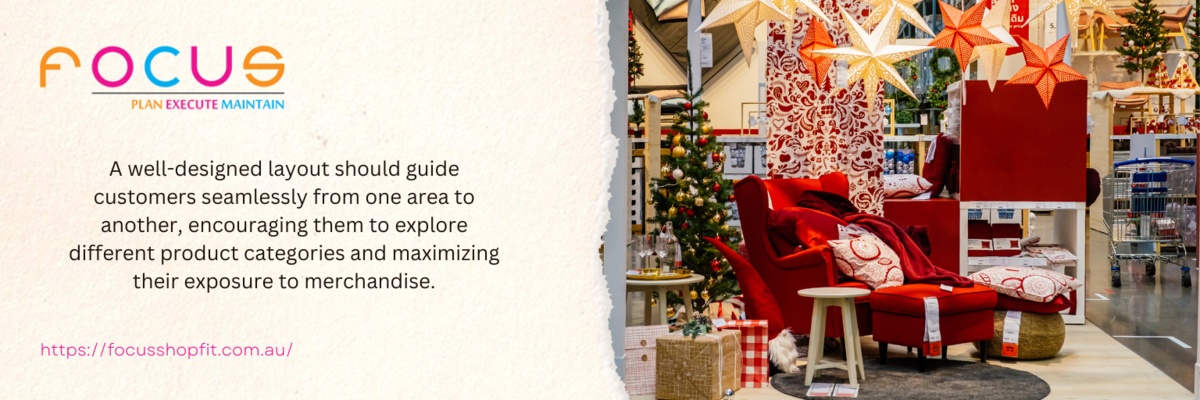Store renovation and shopfitting are crucial aspects of keeping a retail business fresh, appealing, and competitive. As the new year approaches, it is the perfect time to assess your store’s current condition and plan for necessary changes and improvements. Store renovation involves updating the physical space, while shopfitting focuses on ensuring that the store layout, fixtures, and displays are optimized for customer experience and sales. By investing time and resources into planning store renovation and shopfitting, businesses can create a welcoming and attractive environment that drives customer engagement and boosts sales.

First and foremost, store renovation and shopfitting help businesses stay relevant in an ever-evolving market. Consumer preferences, trends, and technology are constantly changing, and retailers need to adapt accordingly. Outdated store layouts, worn-out fixtures, and uninspiring designs can lead to a decline in foot traffic and sales. By planning store renovation and shopfitting, businesses can revitalize their image, attract new customers, and retain existing ones. A fresh and modern store design can create a positive impression, enhance the overall shopping experience, and differentiate the business from competitors.
Additionally, store renovation and shopfitting offer opportunities to optimize the use of space and improve operational efficiency. Over time, a store’s layout may become inefficient, hindering staff productivity and customer flow. By reevaluating the store’s layout during the planning phase, businesses can identify bottlenecks, eliminate wasted space, and create a more streamlined and organized environment. This can lead to improved customer service, easier navigation for shoppers, and better utilization of available square footage.
Benefits of Planning Store Renovation
Proper planning is the cornerstone of a successful store renovation and shopfitting project. By taking the time to carefully consider all aspects of the project, businesses can reap numerous benefits. One of the key advantages of planning is cost control. Without a well-thought-out plan, store renovation and shopfitting projects can easily exceed budgetary constraints. By thoroughly assessing the scope of work, creating a detailed budget, and obtaining multiple quotes from contractors and suppliers, businesses can ensure that the project remains within financial limits. Planning also allows businesses to prioritize renovation tasks based on urgency and available resources, preventing unnecessary expenses and delays.
Another benefit of planning is the ability to minimize disruption to daily operations. Store renovation and shopfitting can be disruptive to both staff and customers, potentially leading to a temporary decrease in sales. By carefully scheduling the project and coordinating with contractors, businesses can mitigate the impact on day-to-day operations. For example, certain renovation tasks can be carried out during off-peak hours or temporary store closures. By planning the project timeline strategically, businesses can minimize inconvenience and maintain customer satisfaction.
Factors to Consider Before Starting a Store Renovation Project
Before embarking on a store renovation and shopfitting project, it is essential to consider several factors that can significantly impact the outcome and success of the project. First and foremost, businesses should have a clear understanding of their goals and objectives for the renovation. Are they aiming to increase foot traffic, improve customer experience, or enhance brand image? By defining these objectives beforehand, businesses can align their renovation plans accordingly and make informed decisions throughout the project.
Budget is another critical factor to consider. Renovation projects can vary widely in cost, depending on the scale and complexity of the changes. It is essential to establish a realistic budget and allocate funds for different aspects of the renovation, including construction, fixtures, materials, and professional services. By accurately estimating costs and setting a budget, businesses can avoid overspending or compromising the quality of the renovation.
Additionally, businesses should consider the impact of the renovation on their staff and customers. Will the store need to be temporarily closed? How will the renovation affect employee schedules and workspaces? By anticipating these potential disruptions and communicating with staff and customers in advance, businesses can minimize inconvenience and maintain a positive relationship with their stakeholders.
Creating a Budget for Store Renovation and Shopfitting
Creating a budget is a crucial step in the planning process for store renovation and shopfitting. A well-defined budget helps businesses allocate resources effectively, prioritize tasks, and control costs throughout the project.
To create a budget, businesses should start by conducting thorough research on the estimated costs of various renovation elements. This includes construction, fixtures, materials, permits, and professional services. It is essential to obtain multiple quotes from contractors and suppliers to ensure accurate pricing information.
Next, businesses should consider any additional expenses that may arise during the renovation process. These can include unexpected repairs, change orders, or modifications to the original plan. By setting aside a contingency fund, businesses can protect themselves from unforeseen costs and keep the project on track.
Once all the costs have been identified, businesses should allocate specific amounts to each aspect of the renovation. This includes categorizing expenses such as demolition, electrical work, plumbing, flooring, painting, fixtures, and professional fees. By breaking down the budget into detailed categories, businesses can better track expenses, identify areas where cost savings can be made, and make informed decisions throughout the project.
It is crucial to regularly review and update the budget as the renovation progresses. Unexpected expenses may arise, and adjustments may need to be made along the way. By closely monitoring the budget and comparing actual costs against the estimated amounts, businesses can ensure that the project remains within financial constraints.
Hiring Professionals for Store Renovation and Shopfitting
Store renovation and shopfitting projects often require the expertise of professionals to ensure a successful outcome. Hiring professionals can save time, minimize costly mistakes, and ensure their project meets all relevant regulations and standards.
One of the key professionals to consider is an architect or interior designer. These professionals have the knowledge and experience to create a functional and visually appealing store layout. They can analyze the store space, understand customer flow, and design a layout that optimizes sales and enhances the overall shopping experience. An architect or interior designer can also provide valuable insights on the selection of materials, fixtures, and finishes that align with the store’s brand image and target market.
Contractors and construction professionals are essential for executing the physical aspects of the renovation. They have the skills and expertise to carry out tasks like demolition, carpentry, electrical work, plumbing, and painting. Hiring licensed and reputable contractors ensures the renovation is done safely, adhering to all building codes and regulations. It is important to obtain multiple quotes and thoroughly vet potential contractors to ensure a high level of quality and professionalism.
In addition to architects and contractors, businesses may also need the services of specialized professionals, such as lighting designers, signage experts, and audiovisual technicians. These professionals can help create a cohesive and engaging store environment that enhances the customer experience and effectively showcases products.

Store Layout and Design Considerations
The layout and design of a store play a significant role in attracting customers, encouraging exploration, and influencing purchasing decisions. When planning store renovation and shopfitting, businesses should carefully consider various layout and design elements to create an inviting and functional space.
One important consideration is the flow of customer traffic within the store. A well-designed layout should guide customers seamlessly from one area to another, encouraging them to explore different product categories and maximizing their exposure to merchandise. The layout should also consider factors such as customer behavior, natural pathways, and the positioning of high-margin products or promotional displays.
Another crucial aspect is creating focal points and visual merchandising displays that capture customers’ attention. Focal points can be created through the strategic placement of eye-catching fixtures, displays, or product showcases. These focal points should be positioned in areas of high customer traffic and should reflect the store’s brand image and desired atmosphere. Visual merchandising displays should be regularly refreshed to maintain customer interest and highlight new products or promotions.
Lighting is another vital consideration in store layout and design. Adequate lighting can enhance the visibility and appeal of merchandise, create a welcoming ambiance, and guide customers through different areas of the store. A combination of general lighting, accent lighting, and task lighting should be used to create a balanced and visually appealing environment.
Businesses should consider the store’s overall aesthetic and branding. The design elements, color scheme, and signage should align with the store’s target market and brand identity. Consistency in design across all areas of the store creates a cohesive and memorable experience for customers.
Selecting the Right Materials and Fixtures for Shopfitting
Choosing the right materials and fixtures is crucial in achieving an attractive and functional store environment. During the planning phase of store renovation and shopfitting, businesses should carefully consider the following factors when selecting materials and fixtures.
Durability is a key consideration, especially for high-traffic areas or areas prone to wear and tear. Materials such as commercial-grade flooring, durable wall finishes, and scratch-resistant fixtures should be chosen to ensure longevity and minimize maintenance costs. Fixtures should also be sturdy and able to withstand frequent use and handling.
Aesthetics and brand identity should also guide the selection of materials and fixtures. The chosen materials should reflect the desired store atmosphere and brand image. For example, a high-end boutique may opt for luxurious materials such as marble or hardwood, while a casual clothing store may choose more affordable and contemporary materials.
Sustainability is an increasingly important consideration for many businesses. By opting for eco-friendly materials and fixtures, businesses can demonstrate their commitment to environmental responsibility and appeal to environmentally conscious customers. Sustainable options include recycled materials, low-VOC paints, energy-efficient lighting, and fixtures made from renewable resources.
Functionality is another critical factor to consider. Fixtures and materials should be chosen based on their intended purpose and the specific needs of the store. For example, clothing racks should be designed to accommodate different types of garments and maximize display space. Shelving units and storage solutions should be selected to optimize organization and accessibility.
Lastly, cost is an important consideration, especially for businesses with limited budgets. While it is essential to prioritize quality and durability, businesses should also seek cost-effective options that offer good value for money. Comparing prices, obtaining multiple quotes, and considering the long-term maintenance costs of materials and fixtures can help businesses make informed decisions and stay within budget.
Timeline and Project Management for Store Renovation
A well-defined timeline and effective project management are essential for the successful execution of store renovation and shopfitting projects. By carefully planning and coordinating all tasks, businesses can ensure that the project stays on schedule and minimize disruption to operations.
The first step in creating a timeline is to identify the key milestones and deadlines for the project. This includes determining the start and end dates, as well as any interim deadlines for specific tasks or phases. Businesses should consider factors such as the availability of contractors, delivery times for materials, and any time-sensitive events or promotions.
Once the milestones and deadlines are established, businesses should create a detailed project schedule. This schedule should outline all tasks, their dependencies, and the estimated duration for each task. It is important to consider potential delays or unexpected challenges that may arise during the renovation process. By building in buffer time, businesses can mitigate the impact of these unforeseen circumstances and maintain the project timeline.
Effective project management involves coordinating and communicating with all stakeholders involved in the renovation. This includes architects, contractors, suppliers, and staff members. Regular meetings should be scheduled to review progress, discuss any issues or concerns, and make necessary adjustments to the plan. Clear lines of communication should be established, and responsibilities and expectations should be clearly defined for all parties involved.
Throughout the project, it is crucial to monitor progress against the timeline and make adjustments as needed. Delays or unexpected challenges should be addressed promptly to prevent further disruptions. By staying proactive and maintaining open lines of communication, businesses can ensure that the renovation project stays on track and is completed within the established timeline.
Tips for a Successful Store Renovation and Shopfitting Process
Store renovation and shopfitting projects can be complex and challenging, but with careful planning and execution, businesses can achieve a successful outcome. Here are some tips to ensure a smooth and efficient renovation process:
Start with a clear vision: Define your goals and objectives for the renovation and communicate them to all stakeholders. This will guide decision-making and ensure alignment throughout the project.
Assemble a strong team: Hire experienced professionals who specialize in store renovation and shopfitting. Their expertise will help navigate challenges and ensure a high-quality outcome.
Communicate with stakeholders: Keep staff, customers, and suppliers informed about the renovation plans and any disruptions that may occur. Maintain open lines of communication to discuss and resolve any concerns or questions.
Plan for contingencies: Set aside a contingency fund and build buffer time into the project timeline to account for unexpected delays or challenges.
Regularly review progress: Monitor the project against the timeline and budget, and make adjustments as needed. Regularly communicate with the project team to address any issues or concerns.
Consider customer experience: Keep the needs and preferences of your target customers in mind when making design and layout decisions. Focus on creating a welcoming and engaging environment that enhances the shopping experience.
Prioritize safety: Ensure that all renovation work is carried out safely and in compliance with building codes and regulations. Regularly inspect the work site and address any safety concerns promptly.
Maintain a clean and organized work environment: A clean and organized work site promotes efficiency and professionalism. Regularly clean up debris, organize tools and materials, and ensure that the work site is safe and accessible.
Plan for reopening: Develop a marketing and promotional plan to generate excitement and drive foot traffic when the store reopens. Consider hosting a grand reopening event or offering special discounts to attract customers.
Evaluate and learn from the experience: Once the renovation is complete, evaluate the results and gather feedback from staff and customers. Identify areas for improvement and apply these lessons to future renovation projects.
By following these tips and investing in careful planning and execution, businesses can ensure a successful store renovation and shopfitting process that leads to a more attractive and profitable retail environment.

Store Renovation and Shopfitting for Business Success
Store renovation and shopfitting are essential for businesses to stay competitive in a rapidly changing retail landscape. By investing in store renovation and shopfitting, businesses can revitalize their image, attract new customers, and improve operational efficiency. A well-planned renovation project can enhance the overall shopping experience, drive customer engagement, and ultimately increase sales. Through careful planning, communication, and execution, businesses can create a welcoming and attractive store environment.
